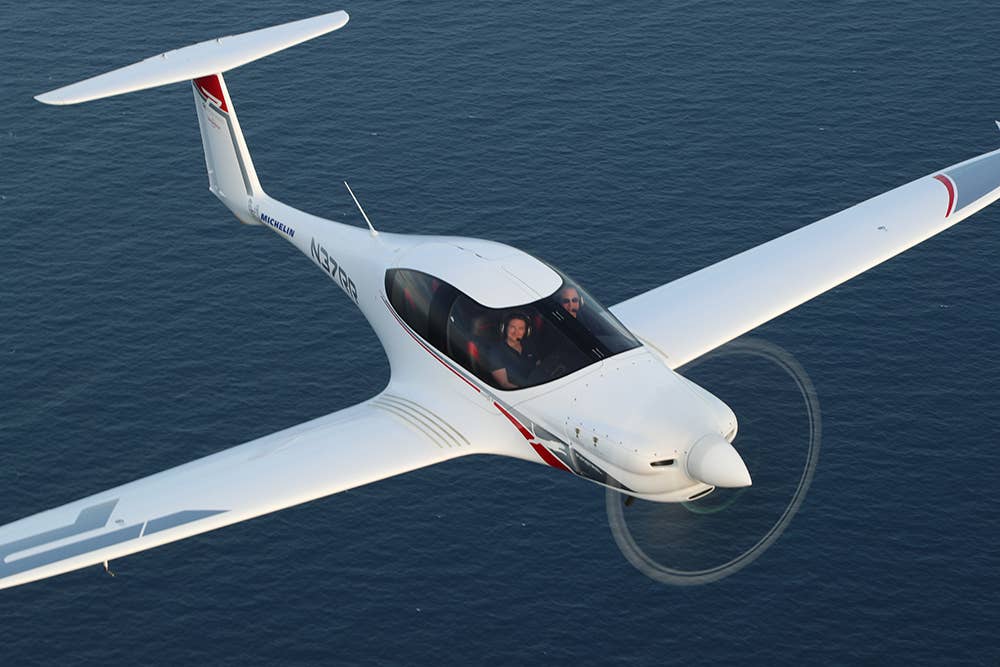Pipistrel Sees Path to EASA Certification of the Panthera
The company says the speedy single-engine retract is aimed for initial approval in 2024.

The Pipistrel Panthera currently flies in the U.S. under experimental exhibition status. [Photo: Jim Barrett]
The much-anticipated initial certification path for the Pipistrel Panthera is underway, according to the company, with the process expected to conclude in 2024. Following its acquisition by Textron, Pipistrel has reconfigured its approach to type certification on the speedy single-engine retract under European Union Aviation Safety Agency (EASA) guidelines, based on the requirements and certification philosophies of its new owner.
“We have a little different expectation of what the aircraft will be capable of at [type certification],” said Rob Scholl, in an exclusive interview with FLYING. Scholl is CEO of Textron eAviation, under which the Pipistrel business unit resides. “The biggest change to the plan is that we want the airplane to be night IFR capable at entry into service. We also think we have the opportunity to bring the G1000 NXi avionics platform to the airplane.”
“There’s just some flight test that needs to be done to wrap up the program,” Scholl continued. “About a two-year timeframe is reasonable to get that through EASA, and then hopefully over through the FAA through the bilateral agreements.”
“The Panthera is going to be a game changer for the light aircraft segment,” said Gabriel Massey, president and managing director at Pipistrel, in a statement. “With capacity for up to four people, a range of 1,100 miles and a cruising speed of 230 miles per hour, this is a high-performance aircraft that will enable traveling at longer distances in great comfort. The Panthera is the ultimate answer for those looking for speed, fuel efficiency, and IFR capability.”
Flying Now—Under Experimental Regs
About a dozen of the Pantheras are already flying in the U.S. under the experimental exhibition category, as Scholl confirmed. The company benefits from real-world feedback from those aircraft in service—though they run the risk of being somewhat orphaned following the changes needed to make TC. However, Scholl doesn’t foresee much of a hurdle here. “The nice thing is, I don’t think there are large-scale requirements to the airplane right now, so those airplanes that are out there, we’ll continue to support them.”
“When [Pipistrel U.S. distributors Andy Chan and Shavonna Reid] mention something to us, we listen to them about the Panthera,” said Scholl, as the pair have been flying the model extensively over the past couple of years from their base at Right Rudder Aviation in Inverness, Florida (KINF).
Powerplant for Initial TC?
The Panthera has been under development with the intent that it could accept a selection of powerplants up front, depending on where the airplane would operate—and the needs of the customer. In fact, last September, Pipistrel flew a hybrid-electric version of the Panthera in Slovenia as a demonstration of the concept. “Good feedback from that—I think it performed well,” said Scholl. “We will continue the development of that platform. I just don’t think we’re ready yet to put a timeline on when that would be available on the marketplace.”
“It could obviously add a sustainability benefit to [the Panthera] and hopefully that will be something that the market will be looking for.”
But Textron eAviation will focus on the engine currently installed in aircraft flying in the U.S.—the Lycoming IO-540V-V4A5—for the initial type certification. “That’s obviously what’s in the aircraft now—for speed, we’re going to focus on that,” said Scholl.
The Lycoming powerplant also looks like it will be a good match for whatever unleaded fuels come out of the EAGLE (Eliminate Aviation Gas Lead Emission) initiative. “I know Lycoming—they’re part of Textron—they’re looking at those initiatives as well,” he said. “We plan on supporting it at the Textron level when those [fuels] are available. We need the supply chain to come together to (a), produce it, regulators to approve it, and then make it available, so we’ll work on those [fuels] as we can.”
On the Velis Electro
While Scholl said that hybrid-electric is not “a complete solution,” it fits in well with the ethos of Textron eAviation. “[For now] there will still be a carbon aspect to it—but we sometimes get wrapped around the fact that we can’t solve the entire ‘lifecycle of the carbon’ aspect—let’s go do our part. We can try to get to a mogas [solution]—most of the Pipistrel products run on mogas today—and we’ve got the Velis, which is electric; we’ll continue that development. We’ve got the Panthera, which is hybrid-electric, so, [we’re] doing what we can through the spaces that we control to help improve the sustainability of aviation.”
The Velis Electro is “a fun airplane to fly,” Scholl agreed—and yes, there’s something odd about holding short of the runway with no engine running, but pilots will likely get used to it should the airplane become widely adopted.
“It’s capable within the vicinity of the airport,” said Scholl, “so if you’ve got an airport that you can go do maneuvers near, or you want to do pattern work, it will suit that mission right now. We’re focused on continuing the development of the platform—I don’t think the airframe [contains] anything that’s a challenge to us. What we’re waiting on is the intersection of the batteries and the airframe, because the airframe has to be a certain size to carry the necessary batteries.”
“I think Tine [Tomažič] and the Pipistrel team have a really good handle on the battery situation, and they’re really the only company in the world that’s done it. We’re not talking about it yet, but I think we have a plan for when we would see the next generation of electric propulsion come out,” Scholl concluded.
The Nuuva and UAM
The other part of Textron eAviation is the Nexus team, which is focused on urban air mobility (UAM). “That effort has shifted from being based with Bell to being based with the eAviation team,” said Scholl. “We’re still pulling resources from Bell…from Textron Aviation.“
“The reason why that’s important is that if you look at what Pipistrel brings to table, they obviously bring a product portfolio and a customer base that is really strong—they’ve delivered about 3,000 aircraft. But the Velis Electro is a great base to test the technology—the technology itself and with the regulators. You can take the learnings from that platform and apply [them] to the Panthera, which [has] a relatively known customer base with the infrastructure [that] already exists, to test out the technology so the regulators are comfortable with a fixed-wing aircraft like that.
“The learnings from both those platforms can be applied to the Nuuva program, at Pipistrel, and a lot of the electric aspects of the Nuuva [V300] derive from the Velis technology. So, the motors, the battery systems—while the Velis is a new and novel design, the underlying technology of the aircraft is known to Pipistrel.”
“We’re doing flight controls, we’re doing electric propulsion, we’re doing thermal management around the motors and the batteries, so for us, the addition of Pipistrel gives us a logical step to bring different products to the marketplace, than being focused on one product..Pipistrel’s engineering team, their experience there, building and selling electric airplanes for a decade—it’s hard to buy that time and experience.”
Textron eAviation is actively working on the path to FAA certification on the Electro, which gained EASA certification in June 2020. “We’re talking with the FAA about the Velis…it’s been TC’ed by EASA, we just got U.K. validation, I don’t know that we’ve announced it yet but we just got the Mexico validation for the Velis, so we are checking the boxes around the world.
“We need the FAA to work with us. There had been some work done between Pipistrel and the FAA prior to COVID, for various reasons during COVID it kind of stalled, so we’ve reinvigorated it.
“I am hopeful that we will get a near-term path with the FAA to allow flight training in the Velis, because I think it will allow benefits to those flight schools, a lower cost—it’s about a fourth the cost of a combustion engine airplane [to operate], and it’s quiet, so you have less impact on the community.”
Scholl believes that eAviation has identified the specific knots to untangle. “The challenge for the FAA is that it is a new and novel technology to them, and the light sport rules with the FAA are a challenge. I have combed through the regulations in this area, and there’s a line in the light-sport classification that says it’s required to be a reciprocating engine. Otherwise, there’s nothing in the light sport rules that prohibit the Velis.”
For the near term, boosting the Electro’s operational capability in the U.S. under the current approval is the primary concern. “We are discussing with the FAA what the path looks like to bring this to a validation or some sort of certification level with the FAA.”

Sign-up for newsletters & special offers!
Get the latest FLYING stories & special offers delivered directly to your inbox






